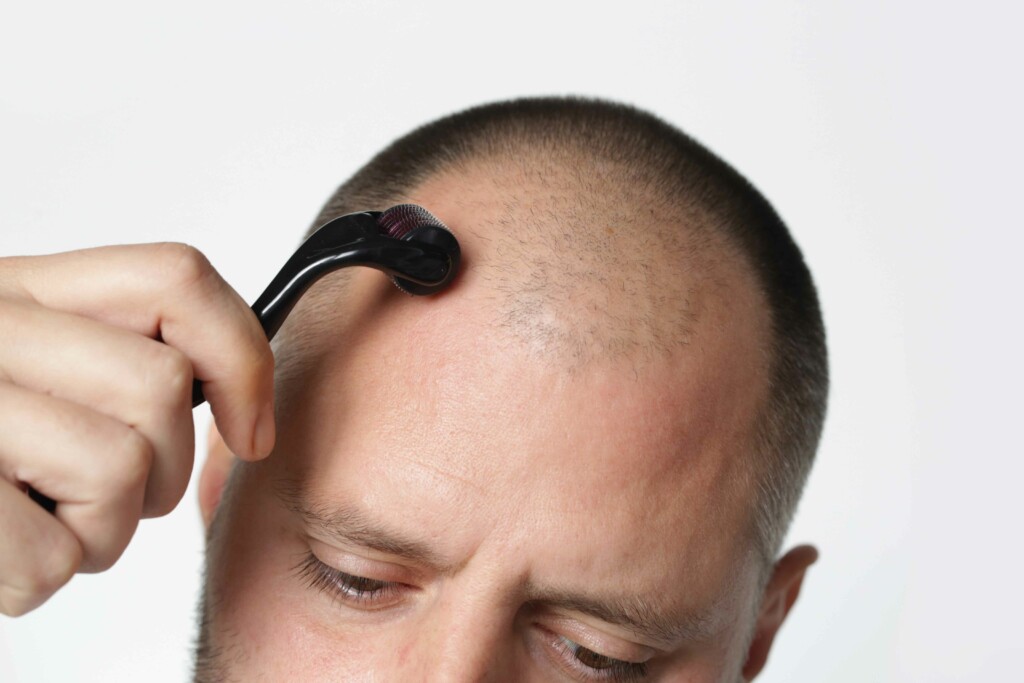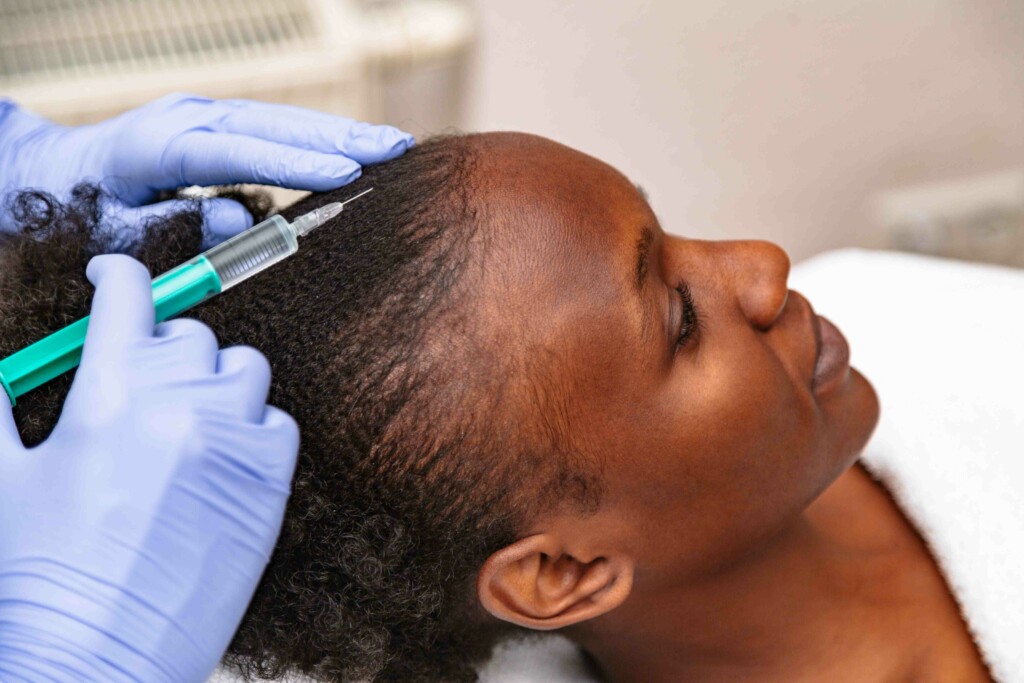Hair loss is an important concern for both men and women. Recent research shows that ketoconazole shampoo can be used to combat scalp conditions that cause hair loss and help slow the progression of pattern hair loss, the most common cause of balding.
Ketoconazole shampoo hair loss treatments are most likely to benefit people experiencing hair loss caused by fungal or other microbial infections. The hormone-blocking properties of this medication also allow it to support people with pattern hair loss (androgenic alopecia), a genetic and hormonal condition.
What Is Ketoconazole?
Ketoconazole is a drug that’s historically been used as a treatment for fungal infections. Research shows that it also has hormone-blocking properties, which make it useful in the treatment of skin conditions and certain hormone disorders. This medication can be used to treat microbial, fungal, inflammatory, and hormonal health issues. (1-4)
Ketoconazole is available in oral and topical forms. Oral ketoconazole products are typically reserved for fungal infections, while creams, gels, foams, and shampoos are used for a much wider array of skin and scalp problems.
What Is Ketoconazole Used For?
When used topically, ketoconazole is mainly used to treat microbial skin infections. However, it can also be used orally to treat systemic fungal infections. Oral ketoconazole is also sometimes used off-label to treat other conditions, including prostate issues, Cushing’s syndrome, and parasitic infections. (2,3)
What Is Ketoconazole Shampoo Used For?
Ketoconazole shampoo is a topical, low-concentration version of this medication that’s generally used for scalp and hair issues. Research shows that ketoconazole can treat the different root causes of hair loss, including fungal infections, yeast infections, and hormone-related hair loss. Ketoconazole shampoo reduces hair loss by fighting these microbes, improving the scalp microbiome, blocking the main hormone associated with hair loss, and soothing inflammation. (1-4)
Ketoconazole shampoo and other topical ketoconazole products are generally available in two concentrations: 1% and 2%. Both 2% ketoconazole shampoo and ketoconazole 1% shampoo have been used to treat scalp conditions and combat hair loss. (4,5) However, while 1% ketoconazole shampoo is available over the counter, 2% ketoconazole shampoo usually requires a doctor’s prescription.
Choosing the Right Ketoconazole Product
The right ketoconazole product is based on the issue you’re experiencing. Oral ketoconazole is still around, but is usually used for serious systemic infections. Ketoconazole foams, creams, and gels are generally used for skin problems occurring on multiple parts of the body. While any of these topical products can be used on the head, ketoconazole shampoo is generally used when the scalp is the main area that’s been affected. (2-4)
Uses for Oral Ketoconazole
Oral ketoconazole is used for systemic fungal infections and hormonal issues like prostate cancer and Cushing’s syndrome. However, it’s no longer considered the be the first choice of treatment as it has the potential to cause problematic side effects.
Side effects of oral ketoconazole include vomiting, abdominal pain, dry mouth, flatulence, and nausea. It can also cause serious liver problems, disrupt adrenal function, and cause irregular heart rhythms, that can even result in death. Because of these issues, oral ketoconazole is mainly used when infections are severe or if alternative treatments are unlikely to work. (2-4)
While you might see some benefits to skin and hair health if you’re already using oral ketaconzole, topical products are generally better at improving the skin microbiome and hair health. Also, doctors prefer prescribing topical ketoconazole products as they are safer and have fewer side effects. Ketoconazole creams, gels, foams, and shampoos typically cause very mild issues, like dry, irritated, or sensitive skin, and dry or greasy hair. (2-4,8)
Uses for Ketoconazole Foams, Creams, and Gels
Ketoconazole foams, creams, and gels are most often used for topical skin infections. These products can be used to treat (2,3,12):
- Fungal acne
- Fungal infections affecting the skin and nails
- Seborrheic dermatitis: rashes caused by a buildup of oils in the skin
- Sebopsoriasis: a mixture of psoriasis, an inflammatory condition that causes skin rashes and some systemic symptoms, and seborrheic dermatitis
- Tinea nigra and tinea versicolor: fungal infections that change skin pigmentation
Several of these issues, including fungal infections, psoriasis, and dermatitis, have the potential to appear on or affect the scalp. If this happens, hair growth may be affected.
Most people experiencing hair loss related to a skin problem are only temporarily affected. This means that once the skin issue is resolved, their hair will grow back.
However, people who are already experiencing some type of hair loss, like androgenic alopecia, may find that skin problems increase certain hair issues, like thinning or shedding. And since androgenic alopecia is progressive, the combination of issues may not only worsen hair loss symptoms but speed up the progression toward permanent balding.
Fortunately, ketoconazole shampoo can also help counteract androgenic alopecia symptoms. This medication has anti-androgenic properties that counteract the hormonal component involved in this form of hair loss. (1,4)
Ketoconazole Shampoo Uses
Foams, creams, and gels can be used on the scalp, but ketoconazole shampoo is often considered to be a more convenient way to deliver medication to the top of the head. This medication is usually used to treat scalp-related conditions that cause symptoms like inflammation, itchiness, dandruff, and hair loss.
Popular ketoconazole shampoo brands include Nizoral, Extina, Kuric, Ketodan, Ketoderm, and Xolegel. Nizoral tends to be the most popular ketoconazole product sold in pharmacies and other stores.
Nizoral anti-dandruff shampoo contains ketoconazole in either 1% or 2% concentrations. Both of these products can help reduce dandruff by combating the bacteria, yeasts, or fungi responsible. When Nizoral is sold as a 2% ketoconazole product, it’s meant to improve the scalp’s microflora and reduce inflammation.
In addition to these products, some brands have created ketoconazole shampoo products designed specifically for hair loss. Certain items, like ultrax labs’ Hair Surge Shampoo, mix ketoconazole with other anti-androgenic ingredients, like the natural dihydrotestosterone (DHT) blockers caffeine and saw palmetto. (6,7)
Blending these types of ingredients together may boost the DHT-blocking effects of shampoo. Applying DHT blockers to the scalp is thought to help stop the progression of pattern hair loss. A number of DHT blockers being tested in clinical trials, including topical dutasteride, Kintor Pharma’s GT20029, and Cosmo Pharma’s Breezula. However, at this time, the only DHT blocker FDA approved as a hair loss treatment is oral finasteride. (4)
Using Ketoconazole for Hair Loss
Ketoconazole shampoo can help resolve hair loss symptoms due to scalp infections and androgenic alopecia. However, when used to treat pattern hair loss, it’s usually considered to be an adjunct or complementary treatment. This means that it should be used alongside another hair loss product. (9,11)
Ketoconazole for Scalp Infections
Scalp infections are mostly due to microbes like bacteria and fungus. Often, a buildup of skin oils and imbalances in the scalp’s microbiome are to blame for infections. Ketoconazole products can greatly improve and treat scalp infections. (2)
Ketoconazole shampoo is a convenient product to use for scalp infections, but creams, gels, and foams can be applied to the scalp, as well. Additionally, there seems to be more research on the benefits of ketoconazole creams and gels for people with scalp and hair issues, implying that the longer the medicine stays on the scalp, the better the treatment’s results. Creams and gels may work particularly well since they are applied directly to the scalp and not rinsed or washed away.
Ketoconazole for Androgenic Alopecia
Current research has shown that 1% ketoconazole shampoo and ketoconazole shampoo 2% may be effective in treating pattern hair loss. Ketoconazole can bind to DHT, which can help reduce miniaturization and inflammation of the hair shafts. Miniaturization is when the hair follicles shrink over time, causing the hairs they produce to become increasingly short and thin. (2)
Using ketoconazole shampoo for hair loss is not approved by the FDA. However, this product can be used alongside FDA-approved treatments like minoxidil, finasteride, and laser hair therapy. In fact, while ketoconazole has been used as an alternative hair loss treatment on its own, it seems to yield the best results when combined with other hair loss treatments. (4,8,9)
How To Use Ketoconazole Shampoo
Ketoconazole 1% shampoo is an over-the-counter product. It can be used by anyone and applied the way you would use a normal shampoo. Just apply to your hair, lather, rinse, and repeat a few days later.
However, for the maximum effectiveness, you’ll want to leave ketoconazole on your scalp for a few minutes. Instead of rinsing immediately after lathering, let the lather sit on your scalp for 5 minutes.
When used for dandruff or hair loss, ketoconazole shampoo is meant to be used two to four times per week. If you’ve gotten a prescription for 2% ketoconazole shampoo for an issue like pityriasis versicolor, you may only need to use the shampoo once. (2,10)
What’s the Best Ketoconazole Shampoo for Hair Loss?
Both 1% and 2% concentrations of ketoconazole shampoo can be used to treat hair loss, although it depends on the issue affecting the hair. Research suggests that 2% ketoconazole shampoo may be the most effective for androgenic alopecia. (9)
At the 2% concentration, this ketoconazole can help decrease inflammation, oil secretion, and improve the flora of the scalp. It also reduces the effect that hormones have on the hair shaft, combating hair thinning and other pattern hair loss symptoms.
However, like all hair loss products, ketoconazole shampoo 2% also comes with a few potential side effects. You may experience issues like itching, changes to hair texture, or skin dryness. For less serious hair loss issues, ketoconazole 1% shampoo may be a suitable alternative. And unlike the 2% shampoo, the ketoconazole 1% is available without a prescription.
It’s also possible to use ketoconazole creams, gels, or foam on your scalp, as well. In fact, leaving the medicine on the scalp for longer, as opposed to rinsing out a shampoo, may be the more effective treatment. However, using the shampoo version of this product may be more practical, convenient, and easier to manage.
References
- Piérard-Franchimont, C., De Doncker, P., Cauwenbergh, G., & Piérard, G. E. (1998). Ketoconazole shampoo: effect of long-term use in androgenic alopecia. Dermatology, 196(4), 474-477.
- Choi, F. D., Juhasz, M. L., & Mesinkovska, N. A. (2019). Topical ketoconazole: a systematic review of current dermatological applications and future developments. Journal of Dermatological Treatment.
- Sinawe, H., & Casadesus, D. (2020). Ketoconazole.
- Perez, B. H. (2004). Ketocazole as an adjunct to finasteride in the treatment of androgenetic alopecia in men. Medical hypotheses, 62(1), 112-115.
- Pierard‐Franchimont, C., Goffin, V., Henry, F., Uhoda, I., Braham, C., & Piérard, G. E. (2002). Nudging hair shedding by antidandruff shampoos. A comparison of 1% ketoconazole, 1% piroctone olamine and 1% zinc pyrithione formulations. International journal of cosmetic science, 24(5), 249-256.
- Hair Surge Shampoo. Ultrax Labs. (n.d.). Retrieved May 26, 2022.
- Gupta, A. K., Talukder, M., & Bamimore, M. A. (2022). Natural products for male androgenetic alopecia. Dermatologic Therapy, e15323.
- Cranwell, W., & Sinclair, R. (2015). Male androgenetic alopecia.
- Fields, J. R., Vonu, P. M., Monir, R. L., & Schoch, J. J. (2020). Topical ketoconazole for the treatment of androgenetic alopecia: a systematic review. Dermatologic Therapy, 33(1), e13202.
- Mayo Foundation for Medical Education and Research. (2022, February 1). Ketoconazole (topical route) proper use. Mayo Clinic. Retrieved May 1, 2022.
- Rajput, R. J. (2010). Controversy: is there a role for adjuvants in the management of male pattern hair loss?. Journal of cutaneous and aesthetic surgery, 3(2), 82.
- Borda, L. J., Perper, M., & Keri, J. E. (2019). Treatment of seborrheic dermatitis: a comprehensive review. Journal of Dermatological Treatment, 30(2), 158-169.
Last updated July 2023




